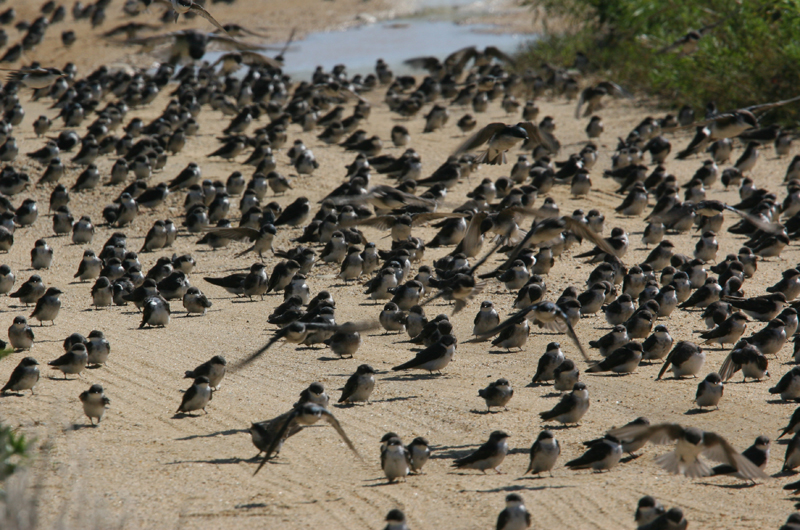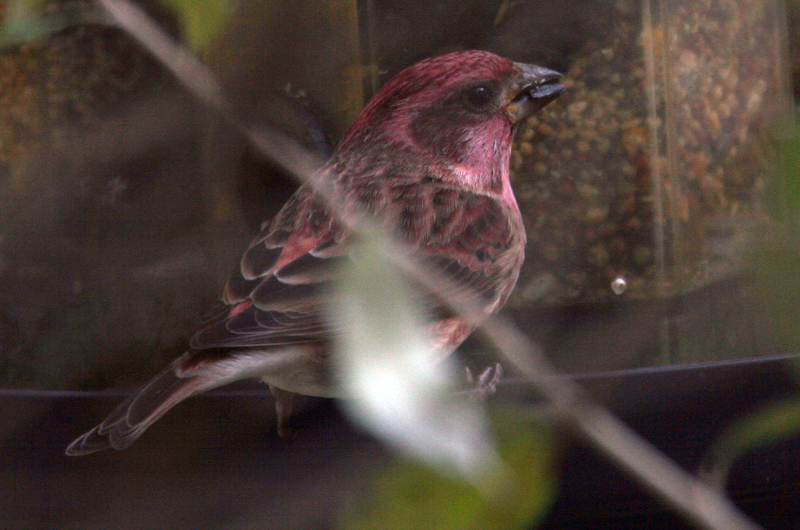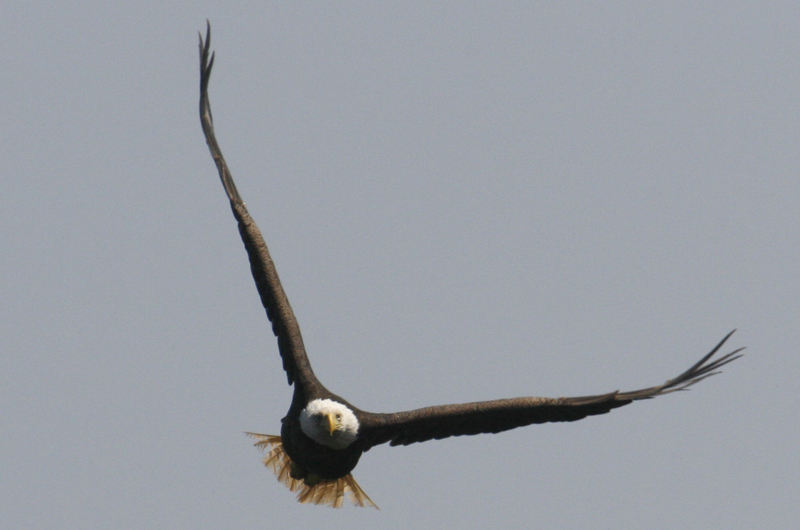Huge flocks of tree swallows can be found almost anywhere along our ocean beaches. How big is huge? Estimates can vary from 5,000 up to 50,000 individuals, and these are probably underestimating their true numbers. These flocks are one of the most amazing natural spectacles you may observe as they dart hither and yon in pursuit of flying insects. Find one of these flocks, and it is not too difficult to position yourself so they are swarming around you. You will be able to hear their twittering and the hum from the thousands of wings beating against the wind.
I estimated that there was one flock of at least 4,000 tree swallows at Long Point on Sept. 14, in addition to a continual stream of swallows moving east to west. Myron Garfinkle covered a larger portion of the south shore beach that morning, and estimated as many as 50,000 individuals. John Nelson and Gail Peters observed a flock of at least 10,000 tree swallows on Cape Poge on Sept. 17.
The flock might settle down into a bush, weighing it down and bending branches nearly to the ground. They will convert it from a green leafy shrub to an iridescent dark blue (adults) and brown (immatures) mass. They might land on the beach, where they will darken the sand for perhaps hundreds of yards, or they might just keep swirling around, gradually moving down the beach.
Go ahead and try to count them. There will be so many that you had better count about 100 of them and then estimate how many units of those 100 birds there are. You will only be able to count individuals if you find them moving down the beach in small flocks of maybe 10 to 20, one flock after another in a nearly continuous stream.
One can easily find videos of murmurations of starlings on the internet, where the huge flock of starlings are moving, twisting and turning in unison, as if they are one organism. It is tempting to call these flocks of tree swallows murmurations, but I will not because the word seems to be used exclusively with large flocks of starlings.
Whatever you call them, these huge flocks are truly worth seeing. While they may be found anywhere on the Island, the best places are East Beach and anywhere along the south shore. Do not wait too long; these large flocks may be gone once October arrives.
Bird Sightings
This week’s bird of the week is a common nighthawk, found by Ken Magnuson flying over the Edgartown Golf Club on Sept. 16. Nighthawks rate this designation because they are not observed every year on the Island. Evenings are often the best time to find these aerial acrobats that catch insects on the wing. The southward migration of songbirds has really picked up its intensity in the past week. So the birding news from the western end of the Island will be a major part of this column for a few weeks. Migrants concentrate there as they wait for favorable weather to continue their migration over the water. Cuttyhunk is the closest land and that island is about seven miles away, a long flight over water.
On Sept. 11, Allan Keith observed a warbling vireo and Cape May, parula, and magnolia warblers at Squibnocket. The next day he had a Connecticut warbler and a hermit thrush at his Chilmark house. On Sept. 16 at Gay Head, he found the first bobolinks of the season along with pine, yellow and a western palm warbler. While at Squibnocket he heard a Virginia rail and saw an indigo bunting, Baltimore oriole, seven species of warblers (Nashville, magnolia, prairie, redstart, common, yellowthroat, yellow-rumped) and three species of vireos (red-eyed, white-eyed, Philadelphia). Then on Sept. 13 he drove out Norton Point and Cape Poge, where he found house wren, short-billed dowitcher, both common and Forster’s terns, and yellow-crowned night-heron.
Ken Magnuson found a Nashville warbler and a purple finch at the Gay Head moraine on Sept. 16. That same day, Soo Whiting and Mr. Keith found a Connecticut warbler there. The next day, Flip Harrington, Mr. Keith, Ms. Whiting and Mr. Magnuson found a veery at the Gay Head moraine.
Meanwhile, at the other end of the Island, John Nelson and Gail Peters observed an empidonax flycatcher (a group of flycatchers that are exceedingly hard to identify unless you hear them singing) on Cape Pogue on Sept. 17. Their other highlights included an adult male white-winged scoter, eight great egrets, four family groups of American oystercatchers, and “oodles of laughing gulls.” There were no terns to be found.
Both bald eagles and peregrine falcons are around now. Bob Shriber, Flip Harrington and Soo Whiting observed a peregrine falcon at Squibnocket on Sept. 17. Ms. Whiting, Barbara Pesch and Barbara Rivers also observed a peregrine at Quenames on Sept. 17. Meanwhile, Zach Weisner reports an immature bald eagle at Squibnocket around Labor Day, while Albert Fischer observed an immature flying over the Keith Farm on Sept. 15, and Valerie Sonnenthal found one at Seth’s Pond recently. Dick Jennings observed an adult bald eagle at Mytoi on Sept. 15. He also observed a merlin chasing tree swallows at the Cape Poge Lighthouse.
Maria Thibodeau found a northern flicker on Sept. 19. Has anyone else noticed that flickers are more common now than they were throughout the breeding season? They seem to be almost everywhere.
Six observers have reported red-breasted nuthatches from Cape Poge to Aquinnah.
Steve Allen reports that the last Early Birders program of the season at Felix Neck was on Sept. 15 and they found great blue herons, belted kingfishers, green herons and cedar waxwings.
Mike Ditchfield observed a solitary sandpiper at a small pond in Dark Woods in Edgartown on Sept. 16.
And finally, there still are a number of ruby-throated hummingbirds hanging around. More than a dozen observers have reported that they still have hummers, so it is still too early to take down the feeders. Southbound migrants are passing through, so go look for them and please be sure to report your sightings to birds@mvgazette.com.
Robert Culbert leads Saturday morning guided birding tours and is an ecological consultant living in Vineyard Haven.








Comments
Comment policy »